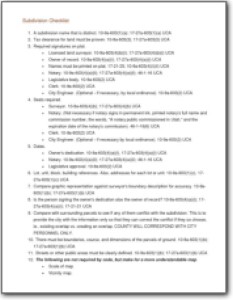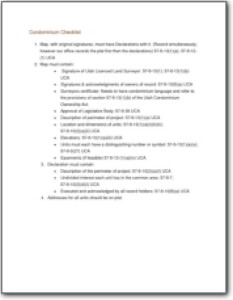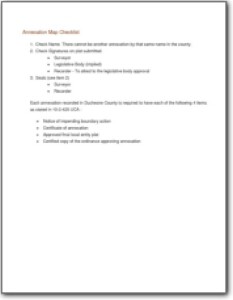Miscellaneous Recording Information
- General
Information - Subdivision
Requirements - Re-recorded
Documents - Combining
Property
General
Information
Each document recorded in the Duchesne County Recorder's office is validated with a recording stamp which includes the Document Entry Number, recording date and time, the fee which was paid for recording, the party who requested the recording of the document, the name of the current County Recorder, the initials of the Deputy Recorder who accepted the document, and the identifier of Duchesne County Corporation. Prior to 2015, the recording stamp also included a Book and Page reference. (Utah Code 17-21).
Our records begin with handwritten abstracting in index books and typewritten entries of documents in books. When reproducing machines were invented, the documents were then copied, first as negative images, and later as regular copies. Documents were also saved on microfilm as a storage precaution. Electronically scanned and stored images are currently being used to keep and share the records.
Subdivision
Requirements
The Recorders Office checks subdivision plats before they are recorded. The checklists we use do not contain all the requirements required by code, but they do contain those which are needed for recording.
Subdivision Checklist

Condominium Checklist

Annexation Map Checklist

Re-recorded
Documents
Read Utah State Code Title 57-3-106
There are three (3) ways to correct an error in a recorded document:
- Recording an affidavit
- Re-recording the document
- Recording a new document with correction reference
What Errors and Omissions can be corrected by an Affidavit?
An incomplete legal description.
- For typographical errors, use a Scrivener's Affidavit.
- For an error in the survey, use a Surveyor's Affidavit
Ambiguous tie legs (i.e. omissions from calls or obvious typo's) that will not allow a point of beginning to be determined
- Use a Scrivener's Affidavit (Note: if a point of beginning can be determined on the original document, whether or not it was the one intended by the executor of the document, an affidavit cannot change the point of beginning.)
An affidavit can correct courses or bearings in a description, if the description will not close without the correction.
If an original document doesn't indicate a plat (i.e. "A" or "B") of a recorded subdivision, an affidavit can be used to clarify the omission. (An affidavit cannot change the plat designation of the original document.)
If the trustee(s) of a trust was left unidentified. Use an affidavit to indicate the trustee or trustees.
An affidavit of identity can be recorded by someone personally acquainted with a grantor or grantee of a previously recorded document to clarify that a person (grantor or grantee) is "also known as" (aka), or was "formerly known as" (fka), or "sometimes known as" by another name which also refers to the same person.
If the Section, Township or Range was missing from the description.
- An affidavit cannot be used to change the section, township or range that was erroneous on the original document.
An error or omission in the acknowledgment.
- A Scrivener's affidavit, preferably from the notary.
What Errors and Omissions can be corrected by Re-Recording the Original Document?
All the errors or omissions described for affidavits above.
If there was no description included on the original document, the description can be included on a re-recording of the document, adding a rider that it was not included by mistake.
All re-recorded documents must include a statement of why the document is being re-recorded.
All re-recorded documents must include new signatures and a new notary acknowledgment to be re-recorded.
The following discrepancies must be corrected by recording an additional, appropriate deed(s) or other document(s)
- Changing the commencing point
- Changing the tie legs to arrive at a different point of beginning than that given on the original document
- Changing or adding the names of grantors
- Changing or adding the names of grantees
- Changing or adding tenancy
- Adding names of additional persons to consent to a previously recorded Boundary Line Agreement
Combining
Property
The Duchesne County Recorder's Office may be directed by a landowner to combine adjacent parcels of property which he or she owns onto one parcel serial number. In some instances this benefits the landowner by reducing the number of tax notices he or she receives, or in some cases, reducing the property taxes. Before landowners have properties combined as one parcel serial number, they may wish to consider:
- Any effect that this combination may have on zoning or subdivision possibilities. (Contact the Planning and Zoning Administrator.)
- Most of the combined description(s) will not show on a single tax notice due to space limitations. The combined descriptions on the tax notice will have the format "First description..., also; Second description..., also;... etc."
The following requirements must be met in order to combine two or more properties onto one tax notice.
- No tax boundary may exist between the properties. (i.e. all properties being combined must be in the same tax district.)
- The parcels to be combined must be contiguous.
- All parcels being combined must have been deeded on the same document. (For example - If the parcels have different vesting deeds, the parcels can not be combined. The owner(s) will have to deed the parcels to be combined and make a request on the document that the parcels be combined.)
If the above requirements have been met, the owner(s) may send a "Request to be Combined" letter, listing the parcel serial numbers of the parcels they wish to combine. This request will become part of the permanent record as a part of a Recorder's Notice document and serves as an authorization to combine the parcels onto one parcel serial number.


